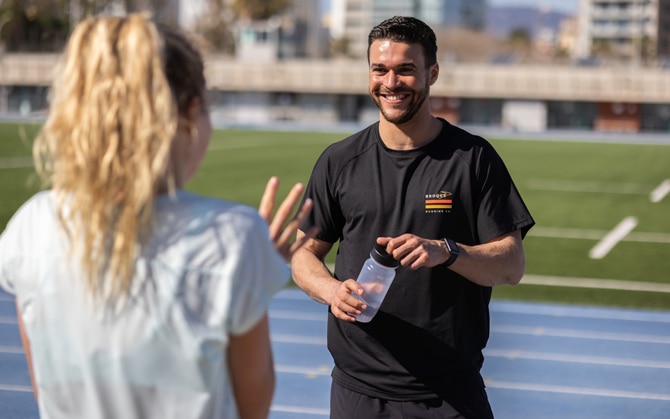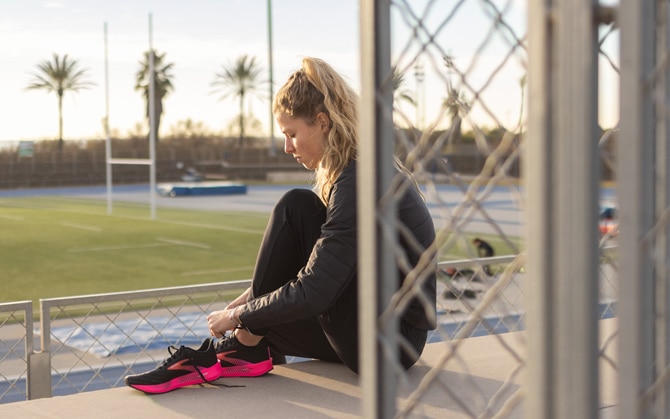Running Recovery & Rest Tips

Brooks Beast Team

Want to avoid feeling burnout and reach your goals more effectively? Brooks Beast head coach Danny Mackey explains why adequate rest and running recovery is an essential part of Run Happy.
What is running recovery?
We know that the run has significant, positive effects on your whole body. It's good for your mind, heart, lungs, and of course, your legs and feet. If it’s so great for us, isn’t more running always better?
Well, not quite. Recovery for runners is just as important as getting the miles in.
Simply put, the body and brain need a break to process the work they’ve done and to prepare for what’s coming next. Without proper mental and physical rest, you run the risk of physical injury, fatigue, anxiety and more.
But what, exactly, does running recovery mean?
When we talk about recovery after runs, we're not just saying that you need a good night’s sleep – although that’s super important, too!
Adequate sleep, usually 7 to 9 hours a night for adults, and potentially an hour or two more than that for athletes, is essential to your overall health. Good sleep is key whether you run marathons or just take short jaunts around the neighbourhood.
However, for proper recovery after running, you’ll need to factor more into your routine than a night of good shut eye. According to Danny Mackey, running rest days should be a designated time when there’s a dedicated focus on recovery, re-synthesis and adaptation. As he explains:
“Without rest, runners will be unable to focus, anxious, under recovered, which is essentially a new term for overtraining. They could become frantic or disorganised and there will be physical output but no peak effort. It’s almost like they’re in a car driving uphill into the wind, flooring the accelerator, but can’t get to max speed. If that keeps on going, they’ll get sick or hurt.”
Exercise is a good thing because it stresses your body beyond its normal homeostasis. Coach Mackey says the best way to reap the benefits from that stress is to take a break.
He explains there are several things that happen to your body as you’re resting:
- Protein synthesis: Muscles can literally be rebuilt during rest
- Rehydration takes place: Your heart’s ability to pump blood through your body improves when you’re resting
- Your parasympathetic nervous system becomes more dominant: This helps to calm all the other systems in your body
All of these activities communicate with your brain, and your brain waves will change for the better too – can you think of any better reason to take running rest days?
Coach Mackey's rest tips for during your run

5 running recovery tips for after your run
We know that recovery after runs is crucial – but how do you do it? Here are our five key tips for recovery after running. Whether you need to recover from a long run or a short speed session, try to work these simple things into your routine.
Cool down properly for good running recovery
You should be warming up before your run (and if you’re not, read this!) but it’s important to take the time to cool down after your session, too, as running recovery can be aided by a thorough cool down. Instead of finishing your run, going straight inside, and putting your feet down, consider tacking an easy jog or walk onto the end of your run to let your body cool down. All you need is 5-10 minutes, but that time will greatly aid your recovery – especially if you’re trying to recover from a long run. A proper cool down helps to lower your heart rate and enables your breathing to return to normal naturally. It also helps to redistribute your blood flow and can help to reduce muscle soreness.
Don’t neglect your stretches
We know you know that one of the main tools available to us all when it comes to recovery for runners is post-run stretching – but how often do you actually make time to do them? Stretching can aid recovery after running as it helps to reduce delayed onset muscle soreness (DOMS) and can prevent common running injuries. Spend a few minutes after your cool down doing some static stretches, which can help to improve your body’s range of motion. That’s important because tight muscles can lead to limited mobility – as you’ll know if you’ve ever tried to do strides with a tight hamstring or calves. Stretching also aids your recovery after runs as it increases blood flow to the muscles that have been working hard, accelerating your recovery, and reducing muscle tenderness to make sure you’re ready for your next run.
Prioritise post-run nutrition
One of the keys to good recovery for runners is eating properly – and quickly – after your run. It’s best to refuel within about 30 minutes of finishing your run – but it’s easy to get distracted once you’ve finished your session. So why not get a head start on your running recovery by preparing protein- and carb- food in advance? Having a snack ready will ensure you eat the right things after your run, especially important to help you recover from long runs. Try a bagel with peanut butter, a peachy quinoa breakfast bowl, or some homemade protein balls.
Get a massage for recovery after running
One of our favourite, but most painful, methods of recovery for runners is a sports massage. Best scheduled for your running rest days, a deep tissue massage can help to reduce muscle soreness and prevent injury. Alternatively, try foam rolling at home. You can roll your calves, quads, glutes, lower and upper back, and you could even get a tennis ball to try some myofascial release for particularly tight trigger points. Massage and foam rolling are good for helping you to recover as they help to work out tight muscles and improve your blood flow, again reducing soreness.
Make sure your easy days are easy
It can be tempting to run fast on every run, but make sure that you’re taking your easy runs at a pace that’s actually easy for you. If you go hard on every session, then you’ll feel constantly fatigued, making running recovery much harder. Speed work and longer sessions put a lot of stress on your body, and you need time to allow damaged tissues to rebuild. Easy runs should be low intensity, allowing you to recover from harder runs and maintain your aerobic fitness levels. Plus, they give you an opportunity to just get out there and enjoy running – there’s nothing quite like an easy run to remind you of why you love it so much!
Rest days for running: how many days do you need and when?
Runners love to discuss how to improve their performance through training and exercise. We love the run so much that we often neglect rest and recovery in our plans.
The number of days you need off running depends on a lot of different factors and will vary from runner to runner. However, one thing’s for sure – everyone needs at least one running rest day. Rest days can reduce stress on your body, as well as actual stress by reducing the amount of cortisol in your body. Resting also contributes to injury prevention.
When you take your rest day (or days, depending on your plan) depends on your own schedule. If you run a lot of miles at the weekend, you might want to take a rest day on Monday to help you recover from a long run. Alternatively, you may want to rest on a Friday to help your legs recover and feel fresh for your long run at the weekend. Or you could bookend your weekend with two rest days for maximum running recovery.
It’s entirely up to you when you take your running rest days. On these days, you might want to go for a walk to keep the legs ticking over. Don’t ignore your need for no speed! Coach Mackey has some top tips to make the most of your rest days:
- Consider a 1:1 ratio in terms of minutes. “If you run for an hour, rest and recover for an hour. It could be meditating, stretching, yoga, or really just chilling. We all have busy lives, but it’s important that rest and running go hand in hand. You need to think of it like a budget.”
- Aim for low levels. “Think of rest in terms of heart rate, brain activity, and movement all at a level one or two out of 10 If you’re into gaming or you like to go out with friends and have a drink, those aren’t really restful activities. They’re probably fun and they’ll improve your mental health and make you happy, but stuff like that will raise your heart rate. You need low-effort activities.”
- Be careful not to rest too much. “Think about how you feel when you sleep in for too long. You feel lethargic after you wake. Too much rest will negatively affect performance in the near term, and in the long term you’ll need to take some time to put yourself back into the correct rest-run rhythm.”

Training tips for when you’re not recovering from running
Now you’ve got recovery after running nailed, it’s time to make sure you’re training optimally too. Want to improve your run performance or get some more tips? It’s important to train your brain as well as your body. Get your fill of running knowledge with more training tips from the Run Happy Blog.